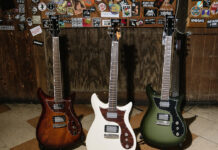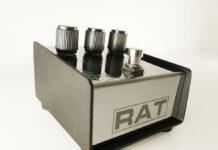
The Secrets Behind Andy Summers' Guitar Sound on The Police's "Walking on the Moon"
Finding out what gear guitarists use isn’t a problem. Most players will gladly recite a list of their favorite guitars and equipment when asked, especially if they have signature model products. If they won’t, there’s usually a good chance that somebody somewhere has at least snapped a photo or two of their guitars and live rigs.
The bigger challenge is finding out how most guitarists use their gear. It’s not the fault of guitar journalists or the artists themselves—cataloging every single guitar played and amp or effect setting used can be a tedious, laborious, time-intensive affair, and many guitarists can’t remember all of the details (that’s why they pay their guitar techs big bucks). I personally can’t remember every knob on certain amps I own, let alone what my exact favorite settings are.
To help you figure out how to create the guitar tones of several iconic songs, we’ve dug deep into research mode, combing old interviews and meticulously examining stage and studio photos from the appropriate eras. I then dug into my personal gear collection of over 100 guitars, 75 amps and 400 pedals and rack processors to replicate those sounds. If I didn’t have particular pieces of gear, I used items like Fractal Audio’s Axe-Fx II XL+ and AX8 (extremely helpful), a Line 6 POD HD500X and various iPad apps, including Positive Grid’s Bias Series and IK Multimedia’s AmpliTube Series.
Much of the original gear used to record these songs is well known, and as a result many of these items are very expensive, if you can even find them. For those of you with limited funds, we’ve also put together more affordable alternative rigs that should provide most of the core elements of these tones. If you want it all, the most affordable alternative may actually be Fractal’s AX8 and a great guitar or two of your personal preference.
Because control markings and layout styles are inconsistent, I’ve listed all settings from 0–10 where 0 is completely off, 10 is all the way up and 5 is exactly in the middle. Keep in mind that the sound of even the same guitars and amp models can often vary dramatically, especially with vintage gear more than 30 years old. If the recommended settings don’t sound quite right, tweak them as you see fit. These settings worked best with my rigs and should get you very close, but variables such as a guitar’s tone woods and pickups can make a difference. Pedals are listed in the order that they should be chained together in series from the guitar to the amp.
Also keep in mind that all of the examples are studio recordings, so the sounds may not be ideal for live performance. Other important elements like the mics, outboard gear and mixing console settings used in the studio while tracking, mixing and mastering can affect the overall tone, so these sounds may not completely match the final product you hear on a record. However, we hope you’ll find that our settings get you most of the way there and inspire you to come up with your own signature sounds to influence new generations.
“WALKING ON THE MOON”
Police, Regatta De Blanc (1979)
Guitarist: Andy Summers
Andy Summers’ playing on this early hit by the Police is a perfect example of how a player doesn’t need to blast or fill every space to make an impression. Instead, Summers impresses with his shimmering textures, inventive suspended chords and restraint, leaving plenty of room for the rhythm section to drive the groove. This approach also was effective in the increasingly larger venues the Police were playing in the late Seventies as their popularity began to grow, creating a sound that resonated throughout the hall.
The key to Summers’ especially sparkling treble comes courtesy of two classic stomp boxes: an MXR Dyna Comp and an Electro-Harmonix Electric Mistress. The compressor gives consistent body to each note in the chords while the Electric Mistress is dialed to a chorus-like effect instead of the usual flanging sweep. An Echoplex set to a single repeat, with the echo volume the same as the dry volume, creates a simple rhythmic effect with a characteristic feel courtesy of overlapping resonant sustain that can’t be duplicated simply by playing two strokes in quick succession.
ORIGINAL GEAR
GUITAR: 1961 Telecaster Custom with maple neck and Gibson neck humbucker (bridge pickup)
AMP: Early Seventies Marshall JMP 1959 Super Lead (Input: I lower, Presence: 3, Bass: 4, Middle: 3, Treble: 6, Volume I: 5)
CABINET: Marshall 4×12 (speakers unknown)
PEDALS: MXR Dyna Comp (Output: 6, Sensitivity: 6), Electro-Harmonix Electric Mistress (Rate: 6.5, Range: 8, Color: 3, Filter Matrix switch: flanger setting), Echoplex EP-3 (Mode: Echo, Delay: 330ms, Sustain: single repeat, Volume: 50/50 dry/echo)
STRINGS/TUNING: D’Addario EXL115 .011 .014 .018 .028 .038 .049/Standard
PICK: Dunlop Jazz II 1.18mm nylon
GET THE SOUND, CHEAP!
• Fender Standard Telecaster
• Marshall DSL 15C combo
• Line 6 M9 Stompbox Modeler
TONE TIP
Use the Marshall’s Classic Gain channel with the gain very low and the volume as high as it will go while still remaining clean. The Line 6 M9 has great models of each effect except the EHX Electric Mistress—use the Tri Chorus instead.
Source: www.guitarworld.com








